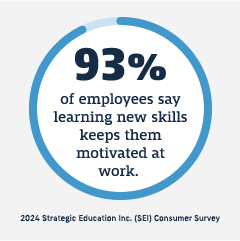- Stretch assignments and cross-functional work. Allowing employees to temporarily take on new responsibilities can help them gain knowledge and become more adaptable.
- Strategic initiatives. When employees participate in strategic projects outside of their day-to-day tasks, they can flex new skills and gain a broader perspective.
- Mentorship and coaching. Employees can get crucial insights from experienced mentors or coaches.
- Formal training. Whether offered by the organization or through an outside resource, training programs help employees work on specific skills.
- Employee-led groups. These groups, sometimes called employee resource groups, are organized around common interests or shared identities. They provide a space for employees to build leadership, networking, and collaboration skills.
- Identify skills. Assess employee skills organizational goals to determine which skills to grow.
- Find learning opportunities. Explore possibilities such as training, education, mentoring, and professional development.
- Set clear, achievable goals. Create accountability by identifying realistic goals and measurable objectives.
- Build a timeline. Establish a time period that includes minor and major milestones, check-ins, and more.
- Make adjustments as you go. Allow room for change and update the plan as goals and circumstances dictate.
Discover Keys to Supporting Employee Growth and Development


As employee demand for continuing education grows, it’s imperative that employers take notice. According to the 2024 Strategic Education Inc. (SEI) Consumer Survey, 91% of workers believe employers should be investing in their continued education.
Another key reason to focus on career growth opportunities for employees is that it’s good business. In fact, 91% of business leaders agree that tuition assistance benefits programs can upskill their workforce which gives organizations a competitive advantage, according to one survey.
Of course, it’s one thing to recognize the importance of creating career growth opportunities for employees. It’s quite another to implement strategies that actually work.
What is growth opportunity in the workplace?
In any organization, opportunities for growth are everywhere. Every task or project is a chance for an employee to build new skills and knowledge. Plus, there are many other growth opportunities in a company that you can leverage.
 |
How to create growth opportunities at work
While it’s true that each individual is responsible for their own career journey, employees look to employers for support. Here are some growth opportunities examples to implement at your workplace.
Know your goals. Identify your company’s key goals and look for employee development opportunities that are aligned.
Assess employee skills. Establish a baseline so you can track growth and progress. Use formal assessment tools, annual reviews, or peer feedback to understand your employees’ skill level.
Build career pathways. When you clearly lay out the steps toward career progression, employees have a roadmap for growth and advancement.
Foster connections. Give employees opportunities to make professional connections within your organization and through industry associations and conferences.
Provide frequent feedback. Set up multiple channels for employees to receive constructive feedback from peers, managers, or even customers.
How to create professional development opportunities for your staff
Perhaps the most important way to create growth opportunities is to build an organization-wide culture of learning and development. Make it clear to employees that the company values skill development for every role and every level. This might include offering training, setting aside hours dedicated to learning activities, or encouraging employees to share knowledge with one another.
Tuition assistance programs are another powerful way to support growth. This sends a strong signal that the organization values employee learning. According to one survey, 90% of business leaders agree that their organization views tuition assistance benefits as an investment in its people.
To get everyone on board, partner with your employees. Collaborate on setting annual goals rather than imposing them top-down. Ask your team what employee growth and development ideas they want to explore—they may identify opportunities you hadn’t considered.
How do you create a growth plan for employees?
Without a clear plan, your employee-development efforts may be unfocused and unlikely to succeed. Here are some tips for staying on track toward better opportunity and career growth.
Maximize your growth opportunities with Workforce Edge
With so many options for employee learning and growth, it can be overwhelming to manage it all. That’s where Workforce Edge comes in. Discover a streamlined and affordable way to facilitate employee learning and education—all in one intuitive online platform. Let’s start a conversation.
As employee demand for continuing education grows, it’s imperative that employers take notice. According to the 2024 Strategic Education Inc. (SEI) Consumer Survey, 91% of workers believe employers should be investing in their continued education.